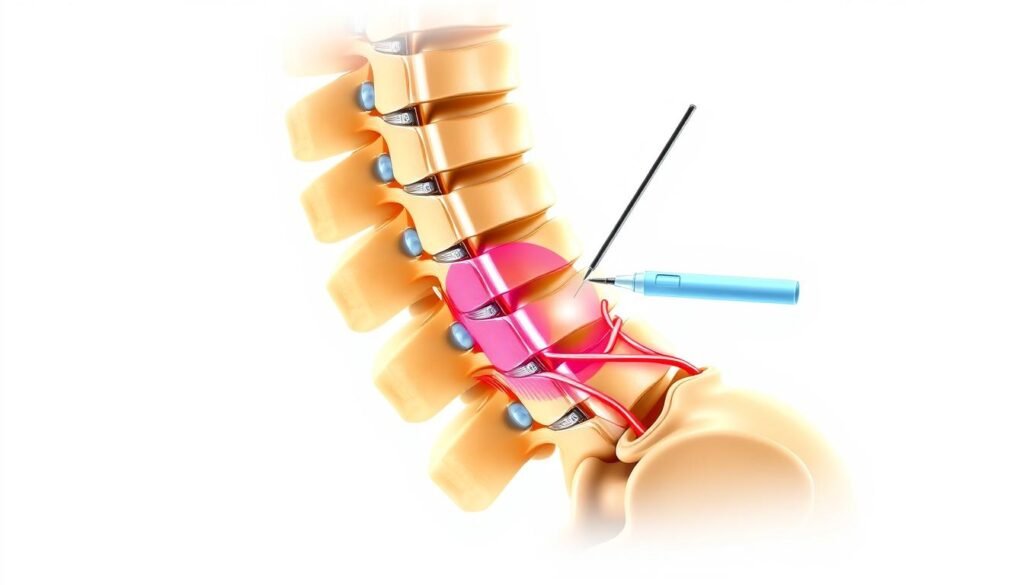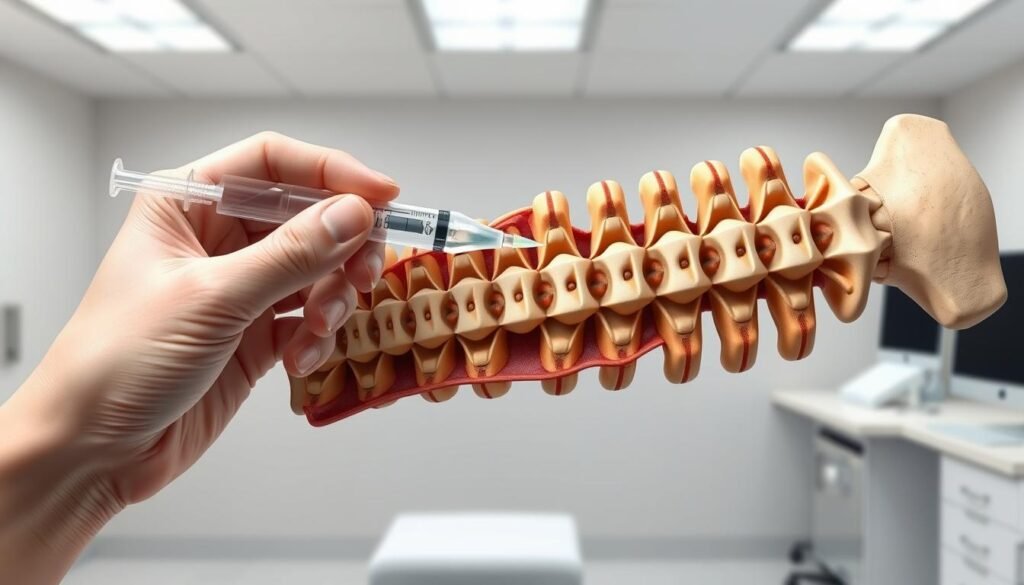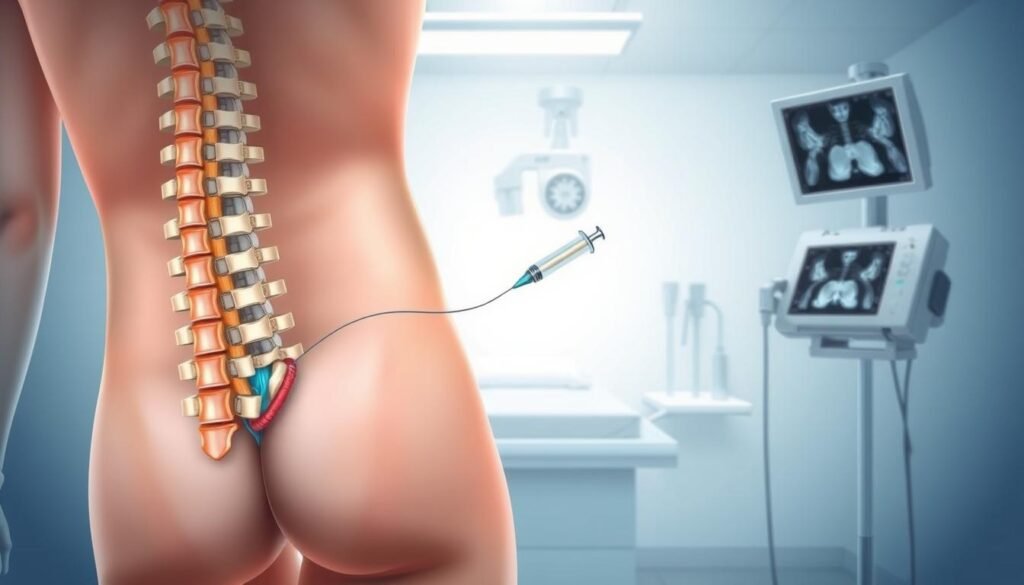Chronic pain in the lower back region can be debilitating, affecting daily life and overall well-being. For many, pain management becomes a priority, and various treatments are available to alleviate this discomfort. One such treatment is the epidural steroid injection, a procedure designed to reduce inflammation and relieve pain.
This medical intervention involves injecting anti-inflammatory medication into the epidural space surrounding the spinal nerves in the lumbar region. By doing so, it targets the source of pain, providing relief for individuals suffering from various spinal conditions. As one of the most common interventions for managing radicular pain, understanding this procedure can empower patients to make informed decisions about their pain management options.
Key Takeaways
- Epidural steroid injections are used to relieve inflammation and pain in the spine.
- The procedure involves injecting anti-inflammatory medication into the epidural space.
- It is a common intervention for managing radicular pain.
- Temporary relief is common, with some patients experiencing longer-term benefits.
- Understanding the procedure helps patients make informed decisions about pain management.
Understanding Lumbar Epidural Steroid Steroid Injection

Lumbar epidural steroid injections have emerged as a significant treatment option for managing lower back pain associated with various spinal conditions. To understand their effectiveness, it’s essential to grasp the basics of what they are and how they work.
Definition and Purpose
A lumbar epidural steroid injection is a minimally invasive procedure designed to deliver steroid medication directly into the epidural space surrounding the spinal cord. This procedure aims to reduce inflammation and alleviate pain in the lower back and legs caused by irritated or compressed nerves.
Anatomy of the Lumbar Spine
The lumbar spine, located in the lower back, is composed of five vertebrae (L1-L5). These vertebrae, along with the intervertebral discs, form the spinal column that protects the spinal cord and facilitates a range of motion. The epidural space is the area outside the sac that contains the spinal cord and nerves, filled with fat, blood vessels, and nerve roots. Understanding the anatomy of the lumbar spine is crucial for comprehending how lumbar epidural steroid injections work and their role in treating back pain related to nerve compression and inflammation.
The lumbar spine bears a significant portion of the body’s weight, making it prone to injury and degeneration. The intervertebral discs play a crucial role in cushioning the vertebrae and facilitating flexibility. However, when these discs deteriorate, they can lead to nerve compression, causing pain. Lumbar epidural steroid injections target this pain by delivering steroids into the epidural space, reducing inflammation and relieving pressure on the nerves.
How Lumbar Epidural Steroid Injections Work
Understanding how lumbar epidural steroid injections work is crucial for patients considering this treatment option. Lumbar epidural steroid injections involve delivering medication directly into the epidural space surrounding the spinal cord. This procedure is designed to reduce inflammation and alleviate pain in the lower back and legs.
The Mechanism Behind Pain Relief
The epidural steroid injection works by targeting the inflamed nerve roots in the epidural space. The medication delivered through the injection contains corticosteroids, which are potent anti-inflammatory agents. By reducing inflammation around the spinal nerves, these injections can effectively decrease pain and improve mobility. For more detailed information on epidural corticosteroid injections, you can visit Hopkins Medicine.
The Epidural Space and Medication Delivery
The epidural space is a fat-filled area between the dura mater (the protective covering of the spinal cord) and the vertebral wall. This space contains fat, the dural sac, spinal nerves, blood vessels, and connective tissue. The medication is precisely delivered into this space using imaging guidance, such as fluoroscopy, to ensure accuracy. The epidural space serves as an ideal delivery route for medication to reach multiple nerve roots simultaneously.
| Approach | Description | Advantages |
|---|---|---|
| Interlaminar | Medication is delivered between the laminae of adjacent vertebrae. | Effective for central disc herniations. |
| Transforaminal | Medication is delivered through the intervertebral foramen. | Targets specific nerve roots; useful for radicular pain. |
| Caudal | Medication is delivered through the sacral hiatus into the epidural space. | Less precise but useful for certain conditions. |
The anatomy of the epidural space can vary between individuals, affecting the distribution and effectiveness of the medication. Understanding these variations is crucial for the successful administration of epidural steroid injections.

Medical Conditions Treated with Lumbar ESI

The application of Lumbar ESI extends to multiple spinal conditions, offering a therapeutic solution for patients experiencing debilitating pain. Lumbar Epidural Steroid Injections have been found to be particularly effective in managing pain associated with various lumbar spine disorders.
Herniated Discs and Nerve Compression
Herniated discs occur when the soft inner gel of the disc leaks out through a tear in the outer disc, potentially compressing nearby nerves and causing pain. Lumbar ESI can help alleviate this pain by reducing inflammation around the affected nerve roots. By injecting steroid medication into the epidural space, the inflammation is decreased, thereby relieving the pressure on the nerves and reducing pain.
Spinal Stenosis and Degenerative Disc Disease
Spinal stenosis is a condition characterized by the narrowing of the spinal canal, which can put pressure on the spinal cord and nerves, leading to pain. Degenerative disc disease involves the wear and tear of the spinal discs, potentially causing pain and stiffness. Lumbar ESI can provide relief for these conditions by reducing the inflammation and swelling that contribute to the narrowing of the spinal canal and the pain associated with disc degeneration.
Sciatica and Radicular Pain
Sciatica refers to pain that radiates along the path of the sciatic nerve, which runs from the lower back through the hips and buttocks and down each leg. This condition is often caused by nerve compression or irritation. Lumbar ESI is particularly effective in treating sciatica by delivering steroid injections directly to the inflamed nerve roots, thereby reducing pain and discomfort. The injections not only provide relief from the inflammation but also help in managing the radicular pain associated with sciatica.
The Lumbar Epidural Steroid Injection Procedure

The lumbar epidural steroid injection procedure is a complex process that requires careful preparation and precise technique. It involves injecting medication into the epidural space surrounding the spinal nerves to alleviate pain and inflammation.
Pre-Procedure Preparation
Before undergoing a lumbar epidural steroid injection, patients typically undergo a thorough medical evaluation to determine their suitability for the procedure. This may include reviewing their medical history, conducting physical examinations, and assessing imaging studies such as MRI or CT scans. Proper preparation is crucial to minimize risks and ensure the effectiveness of the injection.
Step-by-Step Procedure Process
The procedure typically begins with the patient being positioned on their stomach or side. The skin is then cleaned and sterilized, and a local anesthetic is administered to numb the area. Using fluoroscopic guidance, a needle is carefully inserted into the epidural space, and a contrast agent is injected to confirm the needle’s placement. Finally, the steroid medication is administered. The entire process is typically performed under continuous fluoroscopic guidance to ensure accurate placement of the needle.
Types of Injection Approaches
There are several approaches to delivering epidural steroid injections, including interlaminar, transforaminal, and caudal. The choice of approach depends on the patient’s specific condition and the healthcare provider’s professional judgment. Each approach has its advantages and limitations in terms of medication delivery and targeting specific nerve roots.
Recovery and Effectiveness
Understanding what to expect after a lumbar epidural steroid injection is vital for managing expectations and achieving optimal pain relief. The procedure is designed to reduce inflammation and relieve pain in the lumbar region, but the recovery process and the effectiveness of the treatment can vary significantly among individuals.
What to Expect After the Procedure
After receiving a lumbar epidural steroid injection, patients may experience immediate relief, although this can be temporary due to the numbing effect of the local anesthetic used during the procedure. It’s essential to follow post-procedure instructions carefully to minimize potential side effects and ensure the best possible outcome. Some people may resume their normal activities within a few hours, while others might need a day or two to recover fully.

Duration of Pain Relief and Success Rates
The duration of pain relief following a lumbar epidural steroid injection can vary, with many people experiencing several months of improvement in pain and function. Clinical studies have shown that these injections can provide significant pain relief for a substantial percentage of patients, although results can vary based on the specific condition being treated and its severity. If the initial injection is effective, it can be repeated, typically up to 3-4 times per year, as recommended by healthcare providers.
Conclusion: Is a Lumbar Epidural Steroid Injection Right for You?
After exploring the intricacies of lumbar epidural steroid injections, it’s essential to weigh the benefits against the potential risks. This procedure can offer significant pain relief for individuals suffering from chronic back pain caused by various conditions, including herniated discs and spinal stenosis. However, it’s crucial to understand the potential complications, such as infection, nerve damage, and allergic reactions, although these are rare.
When considering a steroid injection, patients should discuss their specific condition and symptoms with their healthcare provider to determine if this treatment is appropriate. Ideal candidates are those who have not found relief through conservative treatments, such as physical therapy and medication. A provider may recommend epidural steroid injections as part of a comprehensive pain management plan.
It’s also important to understand that while epidural steroid injections can provide relief for several months, they are typically part of a broader treatment strategy. For more information on comparing different pain relief options, you can visit this resource. Patients should ask their healthcare providers about the potential benefits and risks, as well as what to expect during and after the procedure, to make an informed decision.

